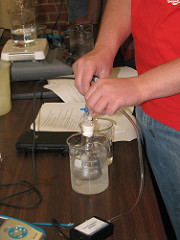Students communicate their results
By Mary Bigelow
Posted on 2016-01-10
 I am interested in strategies to help students write lab reports. I have gone over this at the beginning of the year and a few times in between. But students still have trouble explaining the purpose, hypothesis, process, and conclusion. I want the students to describe and analyze their lab activities and to communicate their findings. Any help will be appreciated. —M., Wisconsin
I am interested in strategies to help students write lab reports. I have gone over this at the beginning of the year and a few times in between. But students still have trouble explaining the purpose, hypothesis, process, and conclusion. I want the students to describe and analyze their lab activities and to communicate their findings. Any help will be appreciated. —M., Wisconsin
Many older textbooks provide templates for students to fill in during “labs” but these do little in terms of students creating their own reports to summarize and reflect on their investigations. The Next Generation Science Standards describe eight practices of scientists and engineers investigating phenomena and solving problems, including carrying out investigations, analyzing and interpreting data, constructing explanations/designing solutions, and obtaining, evaluating, and communicating information. If students do not have much experience in these practices, they will need guidance and scaffolding to become proficient.
When I started teaching, I was excited about doing inquiry-based investigations. But my middle school students were similar to yours. They were confused about observations vs. inferences, and their conclusions were simple summaries of their observations. I did a lot of reflecting: Are my students academically clueless? Am I expecting too much of middle school students?
After observing my students during a few activities, I concluded that my explanations and guidance were insufficient, given that many students were not experienced in basic skills such as questioning, observing, summarizing, formulating hypotheses, graphing, or drawing conclusions. In earlier grades the students did cookbook activities where the purpose and procedures were already determined and the data tables already set up. They may have used some skills in isolation with few opportunities to apply the skills in new situations. Their written reports reflected this lack of experience.
Once you have observed your students and identified baseline data on the skills your students do or do not have, you can begin to scaffold your students’ learning with direct instruction to help them acquire the missing skills, guided practice in a variety of contexts, and opportunities to choose and use the skills independently (even if they make a few mistakes). Here are some ideas:
- Use guiding questions, prompts, and templates to help students focus their thinking. For hypotheses, the template If [I do this], then [this] will happen can show students that a hypothesis is not just an “educated guess.” Show them the difference between testable and untestable questions.
- Share an example of a well-written report on a current investigation. Discuss what makes it a useful documentation of the activity. Share another example of an incomplete or inaccurate one as a comparison.
- Do class demonstrations as a model so the students can observe and focus on a written description, including the list of materials, the procedure, and data tables. Have them compare their descriptions.
- After lab groups conduct an investigation, have students work in their groups to collaboratively write one part of the report (e.g., introduction, methods/materials, observations, results). Ask the groups working on a particular section such as the introduction to read their writing out loud, display it on the board, or use online collaborative tools. Then as a class discuss the section’s strengths and what could be improved.
- Use guiding prompts and questions about the investigation and their data or observations to help students formulate their conclusions.
- Provide students with a rubric or checklist of what should be included in their reports. At first, focus the rubric on specific skills (organizing data, describing the procedure, or formulating a question or hypothesis) and gradually build up to a complete document.
- As an alternative to formal reports, students could communicate about the investigation through posters or infographics.
- Have the students collaboratively write the purpose, question/hypothesis, materials and procedure and then collect data/observations from the lab. For the conclusion, each student supports a conclusion with evidence (data/observations) from the lab.
The investigations will have little learning value unless students make the connections to the content and relate what they’re doing to the performance expectations. Eventually, most students should be able to write a complete lab report. This takes time and patience, but your efforts will pay off when you (and the students) see what they are able to do.
Disclaimer: The views expressed in this blog post are those of the author(s) and do not necessarily reflect the official position of the National Science Teaching Association (NSTA).


